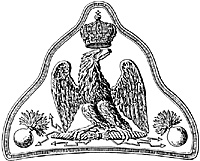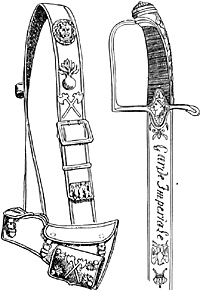Uniform
The coat (habit) was blue with red collar, cuffs, epaulettes and pocket piping, white square-cut lapels, cuff-flaps and turnbacks, and brass buttons. The turnbacks bore aurore grenade badges on a white backing. This was worn with white waistcoat and breeches, and long white or black gaiters for wear in summer or winter respectively. In 1801 the collar was changed to blue, the turnbacks to red and the cuff-flaps became three-pointed. In 1802 a single-breasted surtout came into use as a campaign dress. Although it was worn for the 1806-7 campaigns, only senior NCOs and officers retained it thereafter. It was entirely blue with plain round cuffs and brass buttons. Turnbacks, however, were red and decorated as on the coat, and epaulettes were worn. Officially, overalls were blue.
Officers and NCOs wore the same uniform with the distinctions of rank noted previously, and officers wore tan-topped boots. Sappers had gold crossed-axe badges (edged red) on the upper sleeve, sergeants' epaulettes and mixed red/gold lace on collar, cuffs, lapels and turnbacks, and tasselled loops of the same lace upon the lapels. In addition, the traditional white apron was worn. Drummers had gold lace to collar, cuffs and lapels (and tasselled loops) and, until 1808, red swallows' nests laced with gold. The lace was later mixed with red, and was also worn on the collar and cuffs of the surtout. The Velites wore the same uniform with blue shoulder straps piped red.
Hair was powdered and queued. Moustaches were worn at all times from 1807, but only in winter until then. Sappers; wore full beards.
In 1815 the 3rd and 4th Grenadiers were under-equipped, the 4th to a very bad extent.
 Headdress
Headdress
The famous 'beehive' black bearskin cap was worn throughout. This had a brass plate bearing a grenade, a red rear patch with aurore lace cross and red cords and plume, the latter set above a tricolour cockade. Cords became white after 1800, as did the cross on the rear patch. From 1804 a new plate bearing an eagle flanked by grenades was issued, and in 1808 the cross on the patch was replaced with an embroidered white grenade. On campaign the cap was worn undecorated. Sappers; did not have a plate, but had red and gold cords. A black felt bicorn was provided for wear on the march, with aurore ties and cockade loop, red tassels and pompon and tricolour cockade. The hat, without the ties, was also the head-dress of the Velites, with a red plume for full-dress. Forage caps were blue with aurore trim, tassel and grenade badge.
In 1815 the 3rd Regt. could not be issued with enough fur caps, so a variety of headgear was seen; the 4th Regt. probably had but a handful, if any.
 Grenadiers a Pied: Sapeur's shoulder belt and Officer's sabre
Grenadiers a Pied: Sapeur's shoulder belt and Officer's sabre
Equipment
This was basically as for the Line, although the whitened leather belts had stitched edges - a distinction of Old Guard units. The belt over the left shoulder bore the black leather cartridge pouch, which initially had a brass grenade on the flap - changed to a crowned eagle with a grenade in each corner under the Empire. The other belt bore the sabrebriquet. The sabre had a brass hilt and red knot, changed to white with a red tassel in 1802. Muskets were of the Guard's own model, but this was not often the case in the later years. The strap was white.
A calfskin knapsack was carried on campaign, as well as a personally provided canteen and a blue and white striped ticken was issued in December 1805. The greatcoat was plain blue, but by 1813 at least, there was red piping to collar and cuffs.
Imperial Guard Infantry
-
Grenadiers a Pied
Grenadiers Hollandais
Chasseurs a Pied and Veterans
Marins
Fusiliers
Tiraillers
Conscrits
Voltiguers
Velites and Gardes National de la Garde
Pupilles and Flanquers
Back to Age of Napoleon 18 Table of Contents
Back to Age of Napoleon List of Issues
Back to MagWeb Master List of Magazines
© Copyright 1996 by Partizan Press.
This article appears in MagWeb (Magazine Web) on the Internet World Wide Web.
Other military history articles and gaming articles are available at http://www.magweb.com